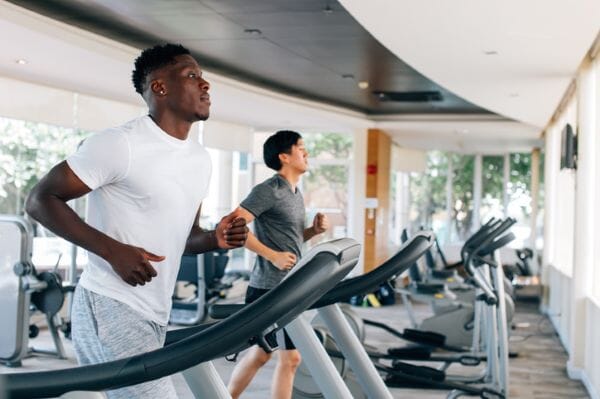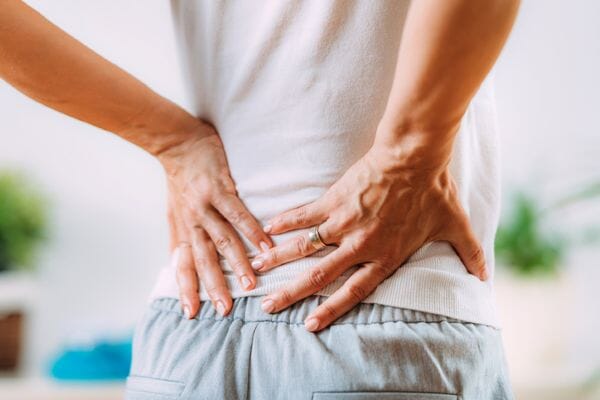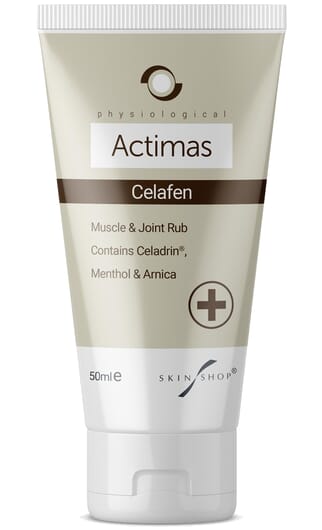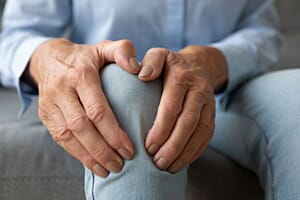For many of us our back to work routine often also includes a back to the gym routine too and many people push themselves harder during this period due to perhaps some weight gain over the summer holiday period.
Summer breaks and holidays can result in many of us letting our gym routines slip, which means that heading back to gym after several weeks break can lead to a greater risk of joint pain and muscle pain caused by injury or strain.

Ignoring gym pain can lead to long term issues that may mean you have to stop going to the gym at all for long periods of recoevry time.
Staying injury-free while going back to regularly working out in the gym is crucial for being able to maintain a regular gym routine over a longer period.
The two most common causes of gym injury and gym pain are the ‘no pain no gain’ mind set, especially when it comes to weight training and secondly a lack of belief in the importance of rest days.
Trying to push through aches and pains can lead to serious gym injuries, and overtraining without rest days can lead to diminishing returns and exhaustion. Overtraining can also cause midday fatigue, excessive soreness, and muscle cramps.
Here are 5 of the most common causes of work out pain and injuries and how to try and prevent them;
RSI
A repetitive strain injury (RSI) is when the muscle of the ligament is repeatedly over-used and/or stretched beyond its limits, which leads to tears or inflammation. These are common injuries if you are weightlifting, running, or doing other repetitive high-impact exercises.

How to prevent RSI
Warm up properly before working out
Concentrate on correct technique rather than just heavier weights
Frequently vary how many repartitions you do and what part of the body you are working out
Don’t go too hard too many or too fast on the repartitions
Always do a thorough stretching routine after working out
Don’t continue exercise through any pain
Tendinitis
Another condition that occurs from weightlifting and circuit training is when the tendons that connect the muscle to bones become inflamed from over-use.
How to prevent tendinitis

Start off with low-impact exercises
Slowly and gradually increase the intensity and duration of workouts
Stretch the muscles that are going to be used before and after working out
Shoulder Tears
Rotator cuff tears are one of the most common shoulder injuries that gym-goers suffer from a result of heavy weightlifting or performing over-head exercises with poor form.

How to prevent shoulder tears
Do shoulder warm up exercises using resistance bands before starting any weightlifting
Slowly strengthen your shoulders by doing exercises such as the shoulder press and lateral raises
Ensure you are using proper form when lifting weights
Avoid overtraining the shoulders as they are more fragile than you think
If you feel pain, don’t push through it
ACL knee injuries
Tearing or straining your ACL or meniscus injuries (an injury to one of the bands of rubbery cartilage that act as shock absorbers for the knees), commonly occur from exercises such as squats, lunges, and jumping.

How to prevent ACL knee injuries
Keep the muscles around the knee strong with warm up exercises, squats and lunges without weights
Avoid overtraining the knees. Remember that knees continue to get ‘worked out’ just from walking around to you need to be extra careful with knees not to over-work them during work outs.
Gradually increase the intensity, weights and duration of knee workouts
Wear proper supportive and grippy footwear
Back Strain
Muscle strains and herniated discs in your back can occur when you do exercises such as deadlifts and squats or use a bad lifting technique.
How to prevent back strain

Ensure you back muscles are strong by doing interim warm up or form building exercises such as rows and pull-ups or swimming.
Pay very close attention to the using the correct technique
Always bend your knee when setting up or putting back weights for your work out
Avoid overtraining your back. The back can take less repeated workouts on a day-to-day basis than many other parts of the body.
Only use weights that you can comfortably lift.
Incorporate multiple and varied back stretches into your routine and take time to do them properly.
5 regular habits that can help reduce the risk of gym pain and injury
1. Drink more liquids when working out
Dehydration doesn’t seem like a risk for injury but in fact research shows that it can lead to more injuries if gym-goers do not drink enough water or liquids (1). Take regular breaks during a workout to re-hydrate.

2. Warm up with resistance bands before any weightlifting
Use resistance bands with low resistance and high reps to gently warm up muscles before starting weightlifting in order to increase blood-flow to the muscles.
3. Take 2-3 full rest days a week
Studies show that taking 2-3 full rest days per week if you are working out intensively and strength training. This is the optimum for proper muscle recovery and strengthening (2). On rest days literally do no exercise other than gentle walking
4. Cross train at least twice a week
Studies show that low-impact cross-training interspersed with more intense weightlifting helps improve results as well as reduces the risk of injury (3) .

5. Treat persistent soreness & reduce inflammation
If you constantly feel sore, this could be a sign of overtraining. While being sore after a workout is beneficial because it tells you your muscles were working out properly, persistent soreness and inflammation is a sign you need to rest (until the soreness stops) and treat the injured area to reduce the inflammation.

Using a topical anti-inflammatory therapy to help reduce inflammation and decrease stiffness can speed up recovery. Try Actimas Celafen, which is a topical formula that offers natural joint pain releif via a patented long chain fatty acid complex called celadrin that has been found in research (4) to help reduce pain and stiffness within 30 minutes of application, which is faster than many oral painkillers while not carrying any of the negative side effects of painkillers. Bristol-based GP Dr Donald Grant who carried out a consumer trial using Celafen for patient joint pain and inflammation says: “There’s good evidence for the efficacy of long chain fatty acids in preparations such as Celafen ™ for the treatment of muscle and joint pain and stiffness. In my opinion it if preparations like Celafen help reduce people’s dependence on painkillers, and there is good evidence to suggest that it might, this can only be a good thing.”
References
1. https://pmc.ncbi.nlm.nih.gov/articles/PMC1323290/
3. https://fitness.edu.au/the-fitness-zone/cross-training-for-enhanced-performance/













